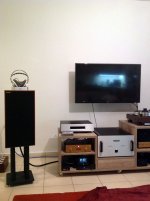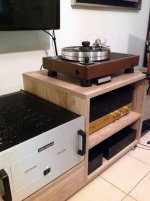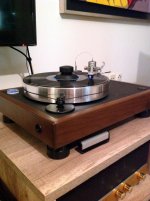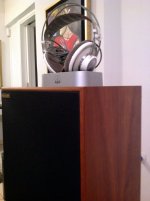I have vu meters which are working with speaker output. How can I regulate them not to rich at the right end? I regulate the front panel screws and the regulators on the vu board. When I pick up the half of the amplifier volume the needles goes to end. Can I use some resistor or something else?
Ok thanksThis one better be a thread on its own including the control circuit you use for the Vu meters. In the solid state section. There they make the power amps and maybe you will get answers much easier than in a preamp thread like here.
I am about to get down to building the dcb1, and am curious if anyone has mated a switchable gain stage? I'm concerned about the dcb1's ability to drive tape and phono.
I'd like to be able to use purely dcb1 for sources like a dac, and then switch on the gain stage if required.
I have tried digging through the posts but it's a little daunting.
I've seen reference to a Bride of Zen BOZ pcb paired with dcb1 by member komigenie.
While I'm not certain that I require this, it would be nice to have the functionality as I wouldn't want to limit myself if my needs from a preamp change.
Since I'm a beginner builder the most straightforward implementation with minimal tweaking would be greatly appreciated.
The posts I'm referencing begins at #4270 on this thread.
I'd like to be able to use purely dcb1 for sources like a dac, and then switch on the gain stage if required.
I have tried digging through the posts but it's a little daunting.
I've seen reference to a Bride of Zen BOZ pcb paired with dcb1 by member komigenie.
While I'm not certain that I require this, it would be nice to have the functionality as I wouldn't want to limit myself if my needs from a preamp change.
Since I'm a beginner builder the most straightforward implementation with minimal tweaking would be greatly appreciated.
The posts I'm referencing begins at #4270 on this thread.
Last edited:
You could build a DCG3 alongside the DCB1 in the same box and set it for any gain you like. You will also get a headphones output from it as a bonus. Can use a more compact common between channels LM317/337 or better chips supply and a single transformer instead of its bulkier double mono DCSTB supplies to save much box space. Not exactly the same result but remains very competent. http://www.diyaudio.com/forums/analog-line-level/296406-salas-dcg3-preamp-line-headphone.html
Thank you for the swift reply Salas. I've learned a wealth of information from reviewing your designs and the builds that follow. Much of the EE side is lost on me however as I am just at the beginning stages as hobbyist.
Is it misguided to approach a buffered / active switch? Should I look into an active design and then reduce the gain on the digital sources? When I switch between the two it seems I get imbalanced presentations at different volume levels in addition to the obvious differences between formats/sources.
My listening is split between 40% DAC, 40% vinyl, the other 10% tape. I'm wondering what is the best preamp "methodology" is to meet all my listening needs.
From my understanding the preamplification needs of dac and phono are on opposite sides of the spectrum. I'm wondering how to happily marry, or compromise the needs of the two.
Sent from my iPhone using Tapatalk
Is it misguided to approach a buffered / active switch? Should I look into an active design and then reduce the gain on the digital sources? When I switch between the two it seems I get imbalanced presentations at different volume levels in addition to the obvious differences between formats/sources.
My listening is split between 40% DAC, 40% vinyl, the other 10% tape. I'm wondering what is the best preamp "methodology" is to meet all my listening needs.
From my understanding the preamplification needs of dac and phono are on opposite sides of the spectrum. I'm wondering how to happily marry, or compromise the needs of the two.
Sent from my iPhone using Tapatalk
Correctly approaching this has more to do with the gain structure of your whole system. If your power amp has less than 28dB voltage gain and your speakers are no more than 90dB/W sensitive a phono or tape source will start lacking in dynamic expression without some line stage gain added to the mix VS the DAC source. Because modern digital replay employing USB can have pretty transparent 64bit OS based digital volume control to back down 6dB or so, there is no normalizing quality penalty in setting priority towards bringing up the phono and tape correctly.
On the other hand if your system gain is high it can do that with unity line gain only so you may employ just a buffer. Can still back down the DAC as above if loud.
As a rule of thumb I would suggest you keep a sum number around 120 as a goal from line and up. That can bring a generally agreeable control range in my experience.
Examples:
You have 85dB speakers and 20dB amp. That's 105. Add 15dB line gain.
You have 95dB speakers and 25dB amp. That's 120. Can use 0dB line gain.
And so on and so forth...
On the other hand if your system gain is high it can do that with unity line gain only so you may employ just a buffer. Can still back down the DAC as above if loud.
As a rule of thumb I would suggest you keep a sum number around 120 as a goal from line and up. That can bring a generally agreeable control range in my experience.
Examples:
You have 85dB speakers and 20dB amp. That's 105. Add 15dB line gain.
You have 95dB speakers and 25dB amp. That's 120. Can use 0dB line gain.
And so on and so forth...
Correctly approaching this has more to do with the gain structure of your whole system. If your power amp has less than 28dB voltage gain and your speakers are no more than 90dB/W sensitive a phono or tape source will start lacking in dynamic expression without some line stage gain added to the mix VS the DAC source. Because modern digital replay employing USB can have pretty transparent 64bit OS based digital volume control to back down 6dB or so, there is no normalizing quality penalty in setting priority towards bringing up the phono and tape correctly.
On the other hand if your system gain is high it can do that with unity line gain only so you may employ just a buffer. Can still back down the DAC as above if loud.
As a rule of thumb I would suggest you keep a sum number around 120 as a goal from line and up. That can bring a generally agreeable control range in my experience.
Examples:
You have 85dB speakers and 20dB amp. That's 105. Add 15dB line gain.
You have 95dB speakers and 25dB amp. That's 120. Can use 0dB line gain.
And so on and so forth...
I'm not familiar with the db gain number you referenced.
I'm currently using 87dB/W/ m speakers (Merlin mme).
The preamp and amplifier pair I've been using for some time is the db-6a and db-1a by db systems. Not very well known or flashy designs but very well respected designs from what I gather. Can I calculate the gain from the numbers on these spec sheets?
Is there a certain formula?
I'm in the process of building one of your folded simplistic RIAAs as I think the phono stage has the most possibilities for improvement. It seems the resolution I am getting from vinyl is being shown up in some areas by my new dac.... which upsets me as someone firmly in the vinyl camp for some time. I thought I would experiment with the dcb1 or a dcb1 + gain stage at the same time if it could bring better / synergistic results.




Sent from my iPhone using Tapatalk
Your power amplifier lists 1V for full power (P) 40W at 8Ω. V=SQRT(P*R)=17.88V RMS
That is 17.88 times the 1V input voltage gain ratio (V2/V1). dBV=20log(17.88)=25dBV
For your 87dBSPL/W/m speakers and your 25dBV gain amplifier driven from my FSP RIAA stage I recommend you the DCG3 line preamp set at 10dbV gain (or 3x). Just back down your DAC output to the FSP average record replay level. A unity gain buffer choice will not bring the dynamics you are after from vinyl in this system. Go read the DCG3 PDF build guide and its thread using the link I gave you before. Good luck with your DIY and let us know.
That is 17.88 times the 1V input voltage gain ratio (V2/V1). dBV=20log(17.88)=25dBV
For your 87dBSPL/W/m speakers and your 25dBV gain amplifier driven from my FSP RIAA stage I recommend you the DCG3 line preamp set at 10dbV gain (or 3x). Just back down your DAC output to the FSP average record replay level. A unity gain buffer choice will not bring the dynamics you are after from vinyl in this system. Go read the DCG3 PDF build guide and its thread using the link I gave you before. Good luck with your DIY and let us know.
looking at your power amplifier specification I see it states 1V (=1Vac) for full output.I'm not familiar with the db gain number you referenced.
I'm currently using 87dB/W/ m speakers (Merlin mme). ..............
That means your amplifier will clip if you input >1Vac with the vol pot turned up to maximum.
The preamp specification states the line stage will have a 1V output (again =1Vac) when the input is 120mV (=120mVac)
If you input more than 120mVac to the preamp with the vol pot set to maximum the power amplifier will clip.
For most modern digital sources, which have 2Vac to 2.4Vac maximum outputs, you will have to turn the vol pot down to ~ -24dB just to stop CD and such like from clipping the output of the power amplifier. You do not need any extra gain.
If you were using a low output digital source with ONLY ½Vac for maximum output you would have to turn down the vol pot to ~ -12dB to prevent the power amplifier from clipping. You do not need any extra gain.
If you had a very low output source with only 120mVac of maximum output you could run the vol pot at maximum and just avoid clipping the power amplifier. You would not need any extra gain.
In all of the above I have used the maximum output at, or just below power amplifier clipping. This level of output would probably result in your neighbours calling the Police to get you to turn down your stereo.
For most of your listening you may want to listen at between 10dB and 20dB below those maximum near clipping levels. Again you do not need any extra gain.
I don't know how Salas arrived at the "120" figure but in my opinion it is giving completely misleading conclusions for required "extra gain".
I could look at how he is using his numbers (and prove they are a nonsense), but the earlier part of my reply should show he is misguiding you !
Similarly, the phono stage is stating a 1.8mVac for full output from the power amplifier.
This is far lower than most conventional MM cartridges produced. Most were between 3mVac and 7mVac for the reference conditions.
There are a few (very few) specialist non Moving Coils cartridges that had an output around 1mVac.
If yours is from this range, then you would need a bit more gain to allow your power amplifier to just reach clipping on well recoded vinyl.
I'd guess you would need some extra gain of +5dB. That would be applied to the RIAA replay chain ONLY, not to the main line level and above.
Last edited:
Here is a misleading nonsensical story on the same theme from me:
I was helping to retube & readjust my good friend's Audio Research VT200 some days ago. A demanding task both for moving around the beast and performing a juggling act when balancing its AC & DC test points looking for its service manual exact voltages and low THD via a multitude of interacting trimmers per channel. Its a four stage symmetrical 200W stereo power amp service affair that took the whole evening among three of us there.
We happily listened to it play again, its a nice system that was down for months due to a couple of 6550 tubes went out catastrophically. Has sixteen of those in groups of four. They killed grid and cathode resistors too. We replaced all 6550s and all ten 6922s.
From when he first put that system together a few years ago he was not happy with his SPL volume control response on a DCB1 long test, he was finding the system quiet enough and lacking in dynamics. He got happy back then only when he adopted a DIY preamp set at 4 times line gain (12dB).
That Audio Research has 22dB gain from SE input at its 8 Ohm taps and his Harbeth SHL5 speakers are 86dB sensitive.
Lets now try my friend's real life comfort zone against my silly "around 120" rule of thumb:
12dB line gain + 22dB amp gain + 86dB loudspeakers = 120
I was helping to retube & readjust my good friend's Audio Research VT200 some days ago. A demanding task both for moving around the beast and performing a juggling act when balancing its AC & DC test points looking for its service manual exact voltages and low THD via a multitude of interacting trimmers per channel. Its a four stage symmetrical 200W stereo power amp service affair that took the whole evening among three of us there.
We happily listened to it play again, its a nice system that was down for months due to a couple of 6550 tubes went out catastrophically. Has sixteen of those in groups of four. They killed grid and cathode resistors too. We replaced all 6550s and all ten 6922s.
From when he first put that system together a few years ago he was not happy with his SPL volume control response on a DCB1 long test, he was finding the system quiet enough and lacking in dynamics. He got happy back then only when he adopted a DIY preamp set at 4 times line gain (12dB).
That Audio Research has 22dB gain from SE input at its 8 Ohm taps and his Harbeth SHL5 speakers are 86dB sensitive.
Lets now try my friend's real life comfort zone against my silly "around 120" rule of thumb:
12dB line gain + 22dB amp gain + 86dB loudspeakers = 120
Attachments
AndrewT thank you for your response and thoughtful information.
Since I have limited background in this area and just getting my feet wet here, one of you could be telling me something that will result in my death from electric shock and one could be showing me the path to audio bliss, but I would not be able to identify which as most explanations at this stage seem perfectly plausible.
Also, since your differing feedback cancels each other out- I would be at a complete loss of making a decision going forward if I were not to have faith in one or the others response.
So, in this case I will trust the response from the person who created both of the builds in question.
Sent from my iPhone using Tapatalk
Since I have limited background in this area and just getting my feet wet here, one of you could be telling me something that will result in my death from electric shock and one could be showing me the path to audio bliss, but I would not be able to identify which as most explanations at this stage seem perfectly plausible.
Also, since your differing feedback cancels each other out- I would be at a complete loss of making a decision going forward if I were not to have faith in one or the others response.
So, in this case I will trust the response from the person who created both of the builds in question.
Sent from my iPhone using Tapatalk
PS As an observation I've noticed that in this hobby this is much more common in any other I've seen. For everything I've researched there's about a half dozen opinions all of which directly contradict each other- kind of like a forum "Mexican shootout" if you will. This generates excessive confusion for any beginner given the density of the subject matter. Just food for thought.
Sent from my iPhone using Tapatalk
Sent from my iPhone using Tapatalk
My FSP Phono adheres to the circa -10dBV (300-350mV) old commercial output standard. As most phono stages do. Your now preamp that you want to upgrade on has 120mV line level sensitivity for 1V output. That's 8.33 times gain or 18.4dB. I recommended you a DCG3 for line duty instead of a DCB1 after the FSP and to back down your DAC a little. Has 3x or ~10dB gain. 3x330mV = 1V. I don't see where I recommended you extra gain from what you now got. With your now preamp the magic gain sum number is 18.4+25+87=130.4 (line+poweramp+speakers). Your then magic number will be 10+25+87=122. The "around 120" ghost is showing up again 
That's OK........................
So, in this case I will trust the response from the person who created both of the builds in question...................
It's what I call "sorting the wheat from the chaff".
make your informed decision. Later when you discover that you can't use much of your vol pot rotation and the top half is unusable because it distorts the sound too much, you can change your mind.
Seems kits are out at the moment for the dcg3.
Also, since I have already built the dcb1 is there a method of adding the 3x gain I require after the output of the dcb1? I've seen some add a boz or borbely stage of some sort?
Could you recommend something available as a fairly straightforward pcb here or elsewhere?
Sent from my iPhone using Tapatalk
Also, since I have already built the dcb1 is there a method of adding the 3x gain I require after the output of the dcb1? I've seen some add a boz or borbely stage of some sort?
Could you recommend something available as a fairly straightforward pcb here or elsewhere?
Sent from my iPhone using Tapatalk
That's OK.
It's what I call "sorting the wheat from the chaff".
make your informed decision. Later when you discover that you can't use much of your vol pot rotation and the top half is unusable because it distorts the sound too much, you can change your mind.
There is no doubt I'll make some poor decisions. I'll bookmark this to return if that is the case.
Like I said before, most responses might as well be written in hieroglyphics. ;-)
Slowly, I'm making my way.
Sent from my iPhone using Tapatalk
The DCB1 and the B1 are Buffered volume controllers.Seems kits are out at the moment for the dcg3.
Also, since I have already built the dcb1 is there a method of adding the 3x gain I require after the output of the dcb1? I've seen some add a boz or borbely stage of some sort?
Could you recommend something available as a fairly straightforward pcb here or elsewhere?
Sent from my iPhone using Tapatalk
You do not add gain AFTER the volume controller.
If any single channel needs extra gain, then add that gain to that channel before it arrives at the vol pot.
The DCB1 and the B1 are Buffered volume controllers.
You do not add gain AFTER the volume controller.
If any single channel needs extra gain, then add that gain to that channel before it arrives at the vol pot.
Yes I understand now, gain precedes attenuation. A potentiometer does not reduce gain but limits it, yes?
This article has been helpful: http://www.diyaudio.com/forums/diyaudio-com-articles/186018-what-gain-structure.html
So, let's say I have a preamplifier with 1V clipping at full volume output, that means a CD player source of 2mv would clip at half volume (12 o'clock).
So, would it make sense to limit a CD players output to 1mv in this case? Or is there a third variable at play?
It seems digital sources and phono are not suitable for each other in preamp matrimony.
Sent from my iPhone using Tapatalk
- Home
- Source & Line
- Analog Line Level
- Salas hotrodded blue DCB1 build



